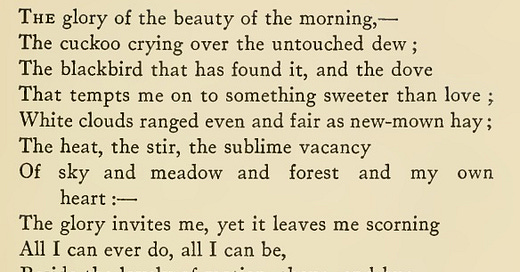Great writers grab hold of perceptions that others can only point at and mumble about. Although many of us have experienced “The glory of the beauty of the morning,—” and perhaps even mentioned it to a passerby with a “lovely weather today!” until Thomas’ poem no one had really grasped that thing about that time of day. How did he do it? Discernment of the world begins with discernment of words, the tools by which we discern the world. And in this line and in this poem Thomas demonstrates his mastery of that humble and essential word, of.
To understand what Thomas has done we need to know the history of of. At its root, of comes from the Old English æf a preposition along the lines of the Latin ab meaning away from. This primeval æf then divided into stressed uses which live on as off and unstressed uses giving us of, which retains the old spelling though we almost always sound it with a v rather than an f. This slight difference can be seen in the following example sentence “Get off of me!”
However in this early stage, of was almost never possessive in the way we use it now, as that function was done with the genitive case. Even today when we express possession with an ‘apostrophe s’ really that apostrophe marks the dropping of the vowel which marked a genitive in Old English; e.g. in the phrase “Jon’s dog” the apostrophe hides Jones, the Old English genitive form of Jon.
Two great Williams then thrust of into prominence as Old English developed into its modern form: William the Conqueror and William Tyndale. While many words in English have roots in Old French due to the Normans, a fact often illustrated by our double vocabulary for Anglo-Saxon animals and their Old French meats such as cow/beef, pig/pork, chicken/poultry, there are also words with a more subtle French influence.
It is easy to spot the direct loanwords, but there is also a set of words which, although common in French, were not assimilated but translated. One such word was the ever-present French de as in “tour de force” or “Marquis de Lafayette” which snuck into English when prefixed to words (e.g. destroy) but was translated when alone as a preposition with of. As English absorbed more and more French phrasings of was used more and more, but still not nearly as much as today.
Then came Tyndale who translated the first English Bible directly from the original Greek and Hebrew rather than from the Latin Vulgate. As Hebrew’s syntax and grammar was in many cases not only different but incompatible with English, Tyndale had no choice but to innovate in order to capture the sense and order of the Hebrew.
One such element of Hebrew was the construct chain, the Hebrew habit of stringing together a pair or even a series of nouns and treating them as one unit. Consider the opening phrase of Exodus in several languages:
In Hebrew we have וְאֵ֗לֶּה שְׁמֹות֙ בְּנֵ֣י יִשְׂרָאֵ֔ל which translated overly literally word-for-word would read: And these names sons Israel.
In the Latin Vulgate, we have Hæc sunt nomina filiorum Israël, which rendered word-for-word would read: These are names sons’ Israel’s. Latin uses a couple of genitives to express the construct chain.
Likewise in the Old English Bible we have Þys synd Israela bearna naman, which rendered word-for-word would read: These are Israel’s children’s names. Again, a couple of genitives.
Yet Tyndale invents a new phrasing to express the Hebrew construct chain writing These are the names of the children of Israel.
To any modern English speaker this phrasing, the-noun-of-the-noun, sounds ordinary, but not so to the 15th century English speaker. It was Tyndale who coined this construction and who coined it a thousand times over due to the incredibly frequent use of this construction in the Bible. The fishes of the sea, and the fowls of the heaven, and the beasts of the field would never be the same.
Thus when Thomas wrote “The glory of the beauty of the morning,—” although he observed a quintessential English nature scene and spoke in a simple straightforward English manner, his construction was warped Hebrew. Although the construction was born of thoughts like “And Abimelech the son of Jerubbaal went to Shechem unto the brethren of his mother, and communed with them, and with all the family of the house of the father of his mother,” Thomas used it for a different sort of thought.
And Thomas’ skill lies in selecting this construction out of all the options English makes available. Consider some alternatives:
“The morning’s beauty’s glory.” Here the possessive sense of the genitive comes on too strong and it sounds ugly. With of expressing a broad sense of connection, that genitive ‘apostrophe s’ has devolved into something too specific, too much like ownership.
Maybe he could have done something more Germanic and turned a noun into an adjective by brute force in the style of ‘Army Strong’ and ‘morning-glory’ and said “Morning beauty glory.” But with two nouns crossdressing as adjectives it all gets muddled and the three overly poetic words in a row with no helpers hit the reader like a troika of unicorns.
If one had to express it without of one might say “In morning’s beauty, there’s a certain glory.” Though this gets at the same specificity as the original, it has divided what was one thing into two. While this version first gives one thing, “morning’s beauty” and then has the reader look at it from a particular angle, “a certain glory,” the original gives us one thing, one cohesive unit.
Besides the specificity and the unity, there is of course the sound of the line. All the little words fill out the line metrically and add just a little consonance. As English’s natural variation of stressed and unstressed syllables comes across wonderfully in this construction, it is no surprise Tyndale’s invention has had such staying power.
And all the years of common use have not yet worn off that original imprint of formal, Biblical language. If such a person still exists, a well read reader cannot help but hear something religious in the line, something like a scripture he had memorized at some point but which has now been lost. And while we could gesture to a few possible allusions:
“the beauties of holiness from the womb of the morning” (Psalm 110:3)
“Give unto the Lord the glory due unto his name; worship the Lord in the beauty of holiness.” (Psalm 29:2)
“And in the morning, then ye shall see the glory of the Lord;” (Exodus 16:7)
“O Lucifer, son of the morning!” (Isaiah 14:12)
all allusions in keeping with the themes of the poem, ultimately the line is Thomas’ own. And a very well read reader will notice in this line something unlike the Bible, the Bible which rarely speaks of the glory of natural things.
And here we see the discovery Thomas has made: there is a glory, a religious awe, a heaviness, to how beautiful the morning is. Though David himself says “The heavens declare the glory of God” and recounts the majesty of the sun “Which is as a bridegroom coming out of his chamber, and rejoiceth as a strong man to run a race,” David never looked away from the hot sun of the orient rising over Jerusalem or over the sheep spangled hill country of Judea, to some small unimportant English farm with a handful of birds to see its glory. That is a humble glory.
The glory of the beauty of the morning is an English glory and an English beauty found in English morning. Every the in the line is essential. It is a specific glory of a specific beauty of the specific morning which Thomas witnessed. And the strength of the line comes in uniting this English love for simple country scenes (e.g. “Pope’s Ode on Solitude”) with Moses’ awestruck “the sight of the glory of the LORD was like devouring fire on the top of the mount in the eyes of the children of Israel.”
Let us briefly consider Thomas’ other uses of of in the poem.
The heat, the stir, the sublime vacancy
Of sky and meadow and forest and my own heart: —
Note how he uses of not just for the sequential, telescoping connection of the opening line, but here for a broad connection, tying one aspect to four different owners.
The glory invites me, yet it leaves me scorning
All I can ever do, all I can be,
Beside the lovely of motion, shape, and hue,
The happiness I fancy fit to dwell
In beauty’s presence.
Instead of a plain noun to start the construction, here we have a substantive adjective with the of delineating what sort of loveliness is being talked about. This would be impossible to express the other way around (e.g. motion’s the lovely) as it is really a different use of of which has 60 uses according to the OED (cf. to’s 9 uses). Yet because it is written in the shadow of the other noun-of-the-noun construction it still looks like it has some of that formality.
Hearkening to short-lived happy-seeming things
That we know naught of, in the hazel copse?
Another different use of of playing off the same similar look. And by ending the phrase on the preposition (as opposed to writing “of which we know naught”) it gives the phrase a dangling feeling, as though the speaker were at a loss for words.
As for the meaning of the whole work, well you can go read it yourself. To borrow a reply from Frost when asked for a poem’s explanation “What do you want me to do? Say it over again in worser English?” The poem speaks for itself.
But the poem will not explain its own history or its own grammar. The poem, like the magician, does not reveal his tricks. Such tricks and tools of the trade are only to be discerned and then supplied to the general public by the Sub-Sub-Librarian in the hopes that the tool might fall into the right hands and once again be put to work.




